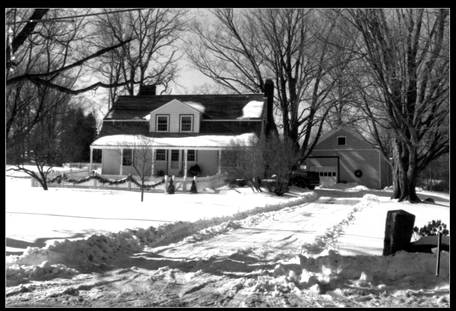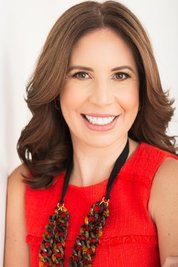
HISTORICAL NARRATIVE - 4 SEARS ROAD
This house is representative of some of the residential architecture that was built on parcels at Southborough center divided out from some of the larger properties at the turn of the century. In this case, the owners were Mr . and Mrs. J. Montgomery Sears, , who built the large mansion across the street at 1 Sears Road for a spring and fall country residence in about 1885. By the late 1890s J . M . Sears had developed a vast farm, called Wolfpen Farm, that stretched north along both sides of Sears Road for over 400 acres, from Main Street north to the Marlborough border. The farm was assembled by consolidating several former farms and residential properties. The lot that this house stands on appears to have been part of the five-acre lot that previously belonged to J . H . Robinson, on which there was an old house at the corner of Main Street and Sears Road, and this one, built by the Sears as a residence for their porter or farm manager in about 1898. A farm lane ran west past the house from a point opposite the spruce-lined driveway across the street, then branched directly west to a north-south farm road, and northwest to the family stables.
Wolfpen Farm and Sears Road
HISTORICAL NARRATIVE
Although most of it has been subdivided for residential development in recent years, the remaining farmstead and associated landscape of the farm that in the 1890s became known as Wolf Pen (Wolfpen) Farm is a vivid reminder of the days when large portions of the north part of Southborough were converted by a few wealthy owners to picturesque, state-of-the-art “gentlemen’s farms.” Although rivaled by Charles F. Choate’s Chestnut Hill Farm, located directly to the west, the largest and most lavish of all was Wolf Pen Farm, which at the turn of the century covered over 400 acres on both sides of Sears Road from Main Street to the border of Marlborough.
In 1877, Sarah Choate of Southborough, daughter of Charles Francis Choate, married the wealthiest man in Boston, J . Montgomery Sears (1855-1905). While their winter residence was in Boston, and they summered in Maine, in 1889 they established a country estate in Southborough at the foot of Sears Road, where they lived in spring and fall. They also began buying property west and north of their house on both sides of the road leading north to Marlborough (later named Sears Road). By the mid-1890s Montgomery Sears, as he was known, owned no less than five of Southborough farms, complete with houses and outbuildings, which he combined into Wolf Pen Farm. Those in the vicinity of Wolf Pen Hill were the old nineteenth-century farms of Eber S. Fay (134 acres-incorporating the former Stow/Newton farm), Nathan L. Johnson (80 acres), and Elijah Crouch (103 acres). Mr. Sears utilized some of the old buildings, including the early-nineteenth-century Johnson and Fay farmhouses, and some outbuildings, including the Fay barn. He installed tenants and farm managers in the houses, building several more residences for his employees, including a house and outbuildings that once stood at 52 Sears Road.
More buildings were added further south on Sears Road. On the west side of the road, Mr. Sears had a blacksmith shop (shown as a “forge” on the map of 1898,) and several rental houses, On the east side, on part of the former Fay farm, were a large house (demolished), assorted outbuildings, and a calf barn. Among the other buildings and structures either listed in tax records or shown on the map of 1898 were a stable, a water tower, a wind mill, two corn cribs, two ice houses, a carpenter shop, two hay ricks, a “swiss cottage”, and a small cheese factory. While nearly all of these have apparently been demolished, a few may have been moved to other locations or reused as modern outbuildings. A gentleman farmer in the truest sense, at the turn of the century Mr. Sears had the only flock of sheep in Southborough (76 sheep in 1900), a dozen goats, a prize herd of over 40 cows (mostly Jerseys) that was rivaled only by that of the Burnetts’ Deerfoot Farm, two bulls, a dozen pigs, 250 fowl, and ten horses.
After Mr. Sears' untimely death in 1905, his sheep herd was sold off. Mrs. Sears continued to operate the property as a dairy farm, however, with her son-in-law James D. Cameron Bradley in charge. The Bradleys resided at 60 Sears Road, which had been built in 1913 as a wedding present from Mrs. Sears. J.D.C. Bradley was also an official of American Agricultural Chemicals Co., and over the course ofhe early twentieth century the farm operations gradually diminished. Like his father-in-law, he died at a young age, and by 1928, his wife, Helen Sears Bradley, was a widow, as well. When Sarah Choate Sears died in 1935, Helen Bradley inherited the house at 1 Sears Road, along with much of both the Sears and Choate real estate in Southborough. She ran Wolf Pen Farm under a farm manager for many years, until its operations were taken over after World War II by her son, J.D.C. (Cameron) Bradley,Jr . Under his management the farm produced many champion Golden Guernsey cows, and operated a farm store in one of the outbuildings. Cameron Bradley, he operated Wolf Pen Farm as a dairy farm until the early 1970s, when 150 head of cattle were sold off. Then, in 1975, most of the remaining acreage of the vast farm, and all the dairy equipment and farm machinery, were sold at auction. Over the last twenty years, subdivisions of large houses on large lots have been built on much of the former farmland.
From Massachusetts Cultural Resources Information System (MACRIS) with recent updates.
This house is representative of some of the residential architecture that was built on parcels at Southborough center divided out from some of the larger properties at the turn of the century. In this case, the owners were Mr . and Mrs. J. Montgomery Sears, , who built the large mansion across the street at 1 Sears Road for a spring and fall country residence in about 1885. By the late 1890s J . M . Sears had developed a vast farm, called Wolfpen Farm, that stretched north along both sides of Sears Road for over 400 acres, from Main Street north to the Marlborough border. The farm was assembled by consolidating several former farms and residential properties. The lot that this house stands on appears to have been part of the five-acre lot that previously belonged to J . H . Robinson, on which there was an old house at the corner of Main Street and Sears Road, and this one, built by the Sears as a residence for their porter or farm manager in about 1898. A farm lane ran west past the house from a point opposite the spruce-lined driveway across the street, then branched directly west to a north-south farm road, and northwest to the family stables.
Wolfpen Farm and Sears Road
HISTORICAL NARRATIVE
Although most of it has been subdivided for residential development in recent years, the remaining farmstead and associated landscape of the farm that in the 1890s became known as Wolf Pen (Wolfpen) Farm is a vivid reminder of the days when large portions of the north part of Southborough were converted by a few wealthy owners to picturesque, state-of-the-art “gentlemen’s farms.” Although rivaled by Charles F. Choate’s Chestnut Hill Farm, located directly to the west, the largest and most lavish of all was Wolf Pen Farm, which at the turn of the century covered over 400 acres on both sides of Sears Road from Main Street to the border of Marlborough.
In 1877, Sarah Choate of Southborough, daughter of Charles Francis Choate, married the wealthiest man in Boston, J . Montgomery Sears (1855-1905). While their winter residence was in Boston, and they summered in Maine, in 1889 they established a country estate in Southborough at the foot of Sears Road, where they lived in spring and fall. They also began buying property west and north of their house on both sides of the road leading north to Marlborough (later named Sears Road). By the mid-1890s Montgomery Sears, as he was known, owned no less than five of Southborough farms, complete with houses and outbuildings, which he combined into Wolf Pen Farm. Those in the vicinity of Wolf Pen Hill were the old nineteenth-century farms of Eber S. Fay (134 acres-incorporating the former Stow/Newton farm), Nathan L. Johnson (80 acres), and Elijah Crouch (103 acres). Mr. Sears utilized some of the old buildings, including the early-nineteenth-century Johnson and Fay farmhouses, and some outbuildings, including the Fay barn. He installed tenants and farm managers in the houses, building several more residences for his employees, including a house and outbuildings that once stood at 52 Sears Road.
More buildings were added further south on Sears Road. On the west side of the road, Mr. Sears had a blacksmith shop (shown as a “forge” on the map of 1898,) and several rental houses, On the east side, on part of the former Fay farm, were a large house (demolished), assorted outbuildings, and a calf barn. Among the other buildings and structures either listed in tax records or shown on the map of 1898 were a stable, a water tower, a wind mill, two corn cribs, two ice houses, a carpenter shop, two hay ricks, a “swiss cottage”, and a small cheese factory. While nearly all of these have apparently been demolished, a few may have been moved to other locations or reused as modern outbuildings. A gentleman farmer in the truest sense, at the turn of the century Mr. Sears had the only flock of sheep in Southborough (76 sheep in 1900), a dozen goats, a prize herd of over 40 cows (mostly Jerseys) that was rivaled only by that of the Burnetts’ Deerfoot Farm, two bulls, a dozen pigs, 250 fowl, and ten horses.
After Mr. Sears' untimely death in 1905, his sheep herd was sold off. Mrs. Sears continued to operate the property as a dairy farm, however, with her son-in-law James D. Cameron Bradley in charge. The Bradleys resided at 60 Sears Road, which had been built in 1913 as a wedding present from Mrs. Sears. J.D.C. Bradley was also an official of American Agricultural Chemicals Co., and over the course ofhe early twentieth century the farm operations gradually diminished. Like his father-in-law, he died at a young age, and by 1928, his wife, Helen Sears Bradley, was a widow, as well. When Sarah Choate Sears died in 1935, Helen Bradley inherited the house at 1 Sears Road, along with much of both the Sears and Choate real estate in Southborough. She ran Wolf Pen Farm under a farm manager for many years, until its operations were taken over after World War II by her son, J.D.C. (Cameron) Bradley,Jr . Under his management the farm produced many champion Golden Guernsey cows, and operated a farm store in one of the outbuildings. Cameron Bradley, he operated Wolf Pen Farm as a dairy farm until the early 1970s, when 150 head of cattle were sold off. Then, in 1975, most of the remaining acreage of the vast farm, and all the dairy equipment and farm machinery, were sold at auction. Over the last twenty years, subdivisions of large houses on large lots have been built on much of the former farmland.
From Massachusetts Cultural Resources Information System (MACRIS) with recent updates.
For more information on 4 Sears Road's history, visit:
Southborough Historical Society
Narrative History of Southborough
Southborough Historical Society
Narrative History of Southborough
